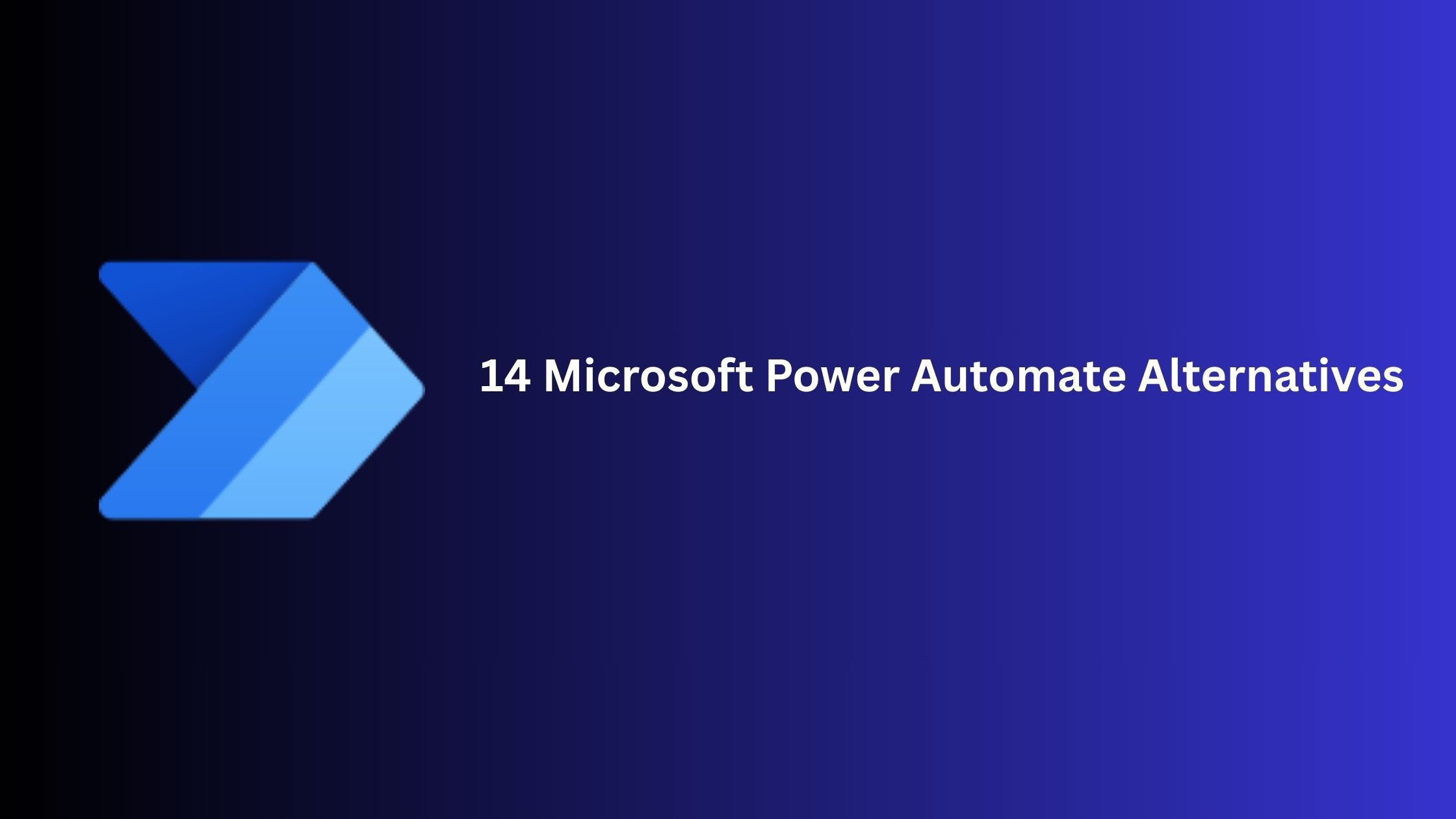14 Microsoft Power Automate Free Alternatives

Although Microsoft Power Automate is a leading business process automation software solution, organizations explore alternatives for many reasons.
These reasons include cost, integration flexibility, ease of use, hosting requirements, and advanced customization needs. This blog will cover 14 Microsoft Power Automate Alternatives, alongside their strengths and weaknesses.
14 Microsoft Power Automate Alternatives
1. Activepieces
Activepieces is an open-source business automation ecosystem featuring the following
- A user-friendly drag-and-drop workflow automation builder similar to Microsoft Power Automate
- AI agents built with natural language
- To-dos for adding human oversight into the automation flow
- Tables
- Model Context Protocols (MCP) for giving agentic capabilities to LLMs like ChatGPT, Claude, and Cursor.
It’s loved by non-technical teams for its ease of use and by technical users for its flexibility and extensibility. It includes a free plan that provides 1,000 tasks per month, and it resets monthly.
Strengths
- Flexible Pricing: Generous free tier and affordable paid plans with unlimited tasks in workflows, avoiding the task-based or workflow-based pricing common in Power Automate and other automation tools.
- Cloud or Self-Hosting: Fully self-hostable for organizations needing complete infrastructure control.
- Wide Integration Library: Works with Microsoft ecosystems, Google Workspace, CRMs, business tools, and developer APIs.
- Beginner-Friendly: Simple enough for non-technical teams yet customizable for developers.
- Security & Compliance: SOC 2 Type II and HIPAA compliant, ensuring enterprise-grade data protection
Limitation:
- Activepieces has 350+ prebuilt integrations, which is slightly less than Microsoft Power Automate. However, the team is consistently adding new integrations. Also, any integration that is not available can easily be integrated into your workflows using APIs without daily limits
Best for: Businesses, Agencies, and enterprises seeking user-friendly but powerful automation solutions with predictable costs and shorter time to value for automation ROI.
2. Zapier
Zapier is one of the most popular no-code automation platforms. It is easy to use with a large number of integrations. It has a free version which allows 100 tasks per month and two steps of automation.
Strengths
- Massive app library
- Easy to use with an intuitive interface
Limitations:
- Pricing can become expensive for high-volume workflows
- No self-hosting option. Companies in highly regulated industries that require their data to reside only on their premises might not find Zapier a suitable option
- Not so developer-friendly
Best for: Organizations that may want mainly cloud-based automation tools, simple workflows, and don’t mind the growing cost
3. Make.com (formerly Integromat)
Make.com is known for its visual workflow editor and ability to design highly customized automation scenarios with conditional logic, branching paths, and data transformations.
Make also has a free version which offers 1000 operations per month (operations are not the same as tasks. A task can take more than one operation depending on complexity)
Strengths
- Flexible design environment, advanced logic handling
Limitations
- Steeper learning curve: It can be overwhelming for simple needs or non-technical teams.
Best for: Technical people or technical teams.
4. n8n
n8n is a source-available (not equal to open-source) business automation platform that offers both cloud and self-hosted deployment. It’s developer-friendly and supports deep customization. n8n does not have a free cloud version, but it has the community self-hosted edition, which is free.
Strengths:
- Self-hosting capability, advanced API integrations
Limitations:
- Requires more technical expertise to set up and maintain compared to tools like Activepieces or Zapier.
- The free version, which is self-hosted requires technical skills and infrastructure overhead
Best for: Technical teams and developers
5. IFTTT
IFTTT (If This Then That) is a web-based automation tool with a focus on consumer and small business use. It connects apps, services, and devices with simple conditional statements.
Strengths:
- Easy to use, supports smart home devices, and works with voice assistants like Alexa and Google Assistant.
Limitations
- Limited complexity; less suited for enterprise-level business process automation.
Best for: Simple automations across web services and IoT devices.
6. Workato
Workato is an enterprise-grade integration and automation platform with AI-enhanced workflows and robust security features.
Strengths
- Scalable for large organizations, strong governance, and compliance
Limitations
- High pricing aimed at enterprise customers may be excessive for small businesses.
Best for: Enterprises
7. UiPath
UiPath is an automation platform that unites AI agents, software robots, and human workers to orchestrate complex workflows at scale.
Strengths
- Comprehensive Automation Ecosystem integrating AI agents, RPA, process mining, and governance tools in one platform.
- Strong Governance & Compliance through role-based access, real-time monitoring, and regulatory controls.
Limitations
- Enterprise pricing can be costly for small or mid-sized businesses.
- Complex learning curve
- Deployment is resource-intensive and may require significant internal IT and change management investment.
Best For
Large enterprises seeking to orchestrate humans, AI agents, and robots
8. Microsoft Logic Apps
Part of the Azure ecosystem, Microsoft Logic Apps enables cloud-based automation and integration with Microsoft and third-party services.
Strengths
- Native Azure integration, enterprise-ready, supports advanced workflows.
Limitations
- Requires Azure knowledge; billed based on consumption, which can be unpredictable.
Best for: Organizations already invested in Azure and Microsoft cloud infrastructure.
9. Tray.ai
Tray’s iPaaS enables businesses to rapidly create and deploy AI agents that integrate seamlessly with existing tools like Slack, web apps, and APIs.
Strengths
- Pre-built accelerators: Ready-to-use templates for common enterprise use cases reduce time to value.
- Scalability and security: It ensures governance, compliance, and safe data use at scale.
Limitations
- Learning curve for customization: While pre-built options are easy to launch, advanced customization may require technical expertise.
- Dependent on the Tray ecosystem: Businesses must operate within Tray’s platform for full functionality, potentially limiting flexibility with niche or unsupported tools.
- Cost considerations: It could be way above small-business budgets.
Best For
- Enterprises
10. Kissflow
Kissflow is a low-code platform designed for multiple personas, including IT leaders, developers, process owners, and business users, enabling collaboration across technical and non-technical teams.
Strengths
- Blend of low-code and no-code: Supports rapid prototyping for technical teams while empowering citizen developers.
- Strong integration capabilities: Instant connections to essential systems via easy, no-code connectors.
Limitations
- Complexity at scale: Large enterprises with highly specialized workflows may require significant customization beyond no-code tools.
- Dependence on platform ecosystem: Heavy reliance on Kissflow’s connectors and tools may create vendor lock-in.
- Potential overkill for small teams: Smaller organizations with simple automation needs may find the platform more robust than necessary.
Best For
- Large and mid-sized enterprises
11. Jitterbit
Jitterbit is an AI-powered integration and automation platform (iPaaS) designed to connect systems, automate workflows, and develop applications with minimal coding.
Strengths
- Layered AI Architecture for enhanced accuracy, transparency, and governance in automation workflows.
- Versatile Platform supporting integration, automation, API management, low-code app development, and EDI in a single environment.
Limitations
- Enterprise- Pricing may be less accessible for small businesses or startups with limited budgets.
- It can be overkill for straightforward automations.
- Learning curve for non-technical teams despite low-code tools, especially in more advanced integration scenarios.
Best For
Large enterprises and mid-sized organizations
12. FlowForma
FlowForma Process Automation is an AI-driven, no-code platform that unites forms, workflows, analytics, governance, and document generation into one solution for end-to-end business process automation.
Strengths
- It combines process automation, form building, analytics, governance, and document generation.
- No-code empowers business users to design and deploy workflows without developer involvement.
Limitations
- May require workarounds for complex cross-platform automation.
- Primarily process-centric and may not be the best fit for organizations needing broad, non-process-based automation.
Best For
Business teams that may need to create, manage, and optimize workflows without heavy IT dependency.
13. Nintex
Nintex is a comprehensive, low-code automation platform that combines workflow automation, document generation, process intelligence, robotic process automation (RPA), and AI-driven capabilities to streamline operations, reduce manual work, and improve efficiency.
Strengths
- Automation capabilities from RPA, document automation, and AI, all in one ecosystem.
- Both cloud and on-premises (self-hosted) options support varying compliance and data sovereignty needs.
Limitations
- Pricing may be expensive for small businesses or startups.
- While it may be low-code, advanced automation and integrations may require experienced configuration.
- Heavier focus on Microsoft/SharePoint ecosystem, which may reduce appeal for companies not invested in these platforms.
Best For
- Enterprises and large organizations that heavily use Microsoft or Salesforce ecosystems
14. ProcessMaker
ProcessMaker is a business process automation (BPA) platform that enables organizations to design, execute, monitor, and improve workflows with minimal technical dependency. It combines process intelligence, intelligent document processing, and agentic AI to streamline operations, reduce manual work, and identify the best automation opportunities.
Strengths
- It combines workflow design, execution, monitoring, and improvement in a single platform.
- It includes agentic AI for autonomous workflows and process intelligence for data-driven automation decisions.
Limitations
- Mid-to-enterprise focus may limit suitability for very small businesses with minimal automation needs.
- Customization complexity for advanced or highly specialized workflows may still require developer support.
Best For
Mid-size to large enterprise businesses


